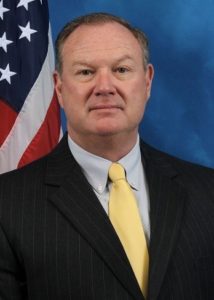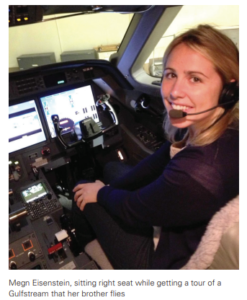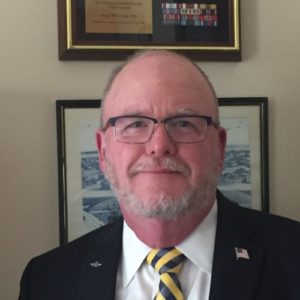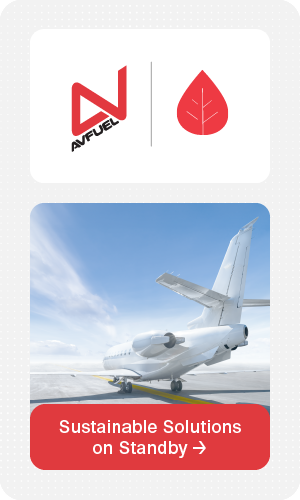In an industry as full of passionate people as general aviation, everyone has a story of falling in love with flying. As the members of the NATA Regulatory Affairs team began sharing those stories, it became clear
that such tales—of initial sparks and of the careers they inspired—can play a critical role in motivating the next generation across all aspects of the industry.
 “My story started very early on, when I was only four or five years old,” recalls Keith DeBerry, NATA’s Senior Advisor for Regulatory Affairs, Maintenance. “A friend of my grandfather’s had a biplane—you know, fabric and dope—and he and his wife would give rides for money. He landed in one of my grandfather’s fields one day when I was just a boy and, in that instant, I became enamored with aviation, for life. That’s where it all started! I immediately started asking, ‘What makes it fly? What makes it stay in the air?’ I’ve always had a curious mind about what makes things click, so I was immediately drawn to anything to do with the mechanical aspect. Getting some answers to those questions really laid the groundwork for all the rest of it.”
“My story started very early on, when I was only four or five years old,” recalls Keith DeBerry, NATA’s Senior Advisor for Regulatory Affairs, Maintenance. “A friend of my grandfather’s had a biplane—you know, fabric and dope—and he and his wife would give rides for money. He landed in one of my grandfather’s fields one day when I was just a boy and, in that instant, I became enamored with aviation, for life. That’s where it all started! I immediately started asking, ‘What makes it fly? What makes it stay in the air?’ I’ve always had a curious mind about what makes things click, so I was immediately drawn to anything to do with the mechanical aspect. Getting some answers to those questions really laid the groundwork for all the rest of it.”
DeBerry’s career arc in aviation began with a 22-year stint in the U.S. Air Force.
“The day I entered the Air Force—May 17, 1976—I knew that aviation was going to be my lifelong career, and now here I am, 45 years later. I didn’t think twice about it. Hence the advice I often give people: find what you want to do as early as possible and stick with it. And so, I did! I applied myself and just kept working towards the goal.”
His first job?
“I was an Air Force maintenance technician for a number of years,” DeBerry says. “Talk about instant gratification, when you can fix an airplane, button it up, and then turn and see it take off and fly? Whoo-ee! I always loved that aspect of the job. And belonging to something larger than myself was equally gratifying: not just the national security aspect of the Air Force, but that larger sense of being a part of it all, of being involved in aviation, of being involved in my country, all of it.”
A later assignment as chief of maintenance for the Thunderbirds USAF Air Demonstration Squadron helped DeBerry appreciate the value of his own first exposure to aviation and come to understand the influence that seeing a demonstration can have on inspiring future generations.
“A huge percentage of people who serve in the Air Force say they joined because of seeing the Thunderbirds fly, and that’s a lesson we can learn from industry-wide,” he says. “We should be getting out there at every opportunity to go out in the community, to show young people what aviation is all about, to talk with people about careers in aviation. We should tell our stories of how we fell in love with aviation, and we should explain those emotions of accomplishment, of enthusiasm, of passion that we feel for our industry. For a young person looking for their way in the world, hearing people who are excited about their careers really causes things to start to turn.”
When DeBerry talks about aviation, he isn’t afraid to use the word “sexy.”
“That was my earliest impression, that flying was all about bravado, and I wanted to be part of that! I just became entranced with it. Even today—I’ll be 64 in December—when I hear an airplane fly over, I’ll stop and look up,” DeBerry says. “People in aviation everywhere have that same love, that same feeling, and for most of us it has also meant world travel, meeting new people, seeing new places, doing new things. See what I mean? Sexy. We used to tell that story, but I don’t think we tell it enough these days.”
DeBerry’s work with the Thunderbirds was, serendipitously, his first opportunity to meet folks from the Federal Aviation Administration, and it’s another aspect of the aviation industry he likes to share with young people: aviation careers can take all kinds of unexpected twists and turns.
“I collected a stack of those people’s business cards over the years. When I got ready to retire from the Air Force after 22 years, I thought, ‘This might be fun,’ so I applied to the FAA and received three job offers pretty quickly,” he says. “I came to the FAA with what I thought was the depth and breadth of experience needed for civil aviation, but I was wrong! Military aviation is a lot different than civil aviation. So, it was a whole new adventure in aviation, and I learned a tremendous amount.”
Now, DeBerry says, he’s interested in helping create new pathways forward to help kickstart next-generation careers in aviation.
“I think we’ve done the next generation a disservice by not promoting air transportation more actively,” DeBerry says. “If I hadn’t had a pathway through the Air Force, I probably would have been a farmer, honestly. And that just wasn’t for me. The message I think is worth sharing is that if you go get your certificates and your training, you can find a job in aviation—a thrilling job!—anywhere in the world.”
 Megan Eisenstein, NATA’s Managing Director, Industry & Regulatory Affairs, says the first sparks of her own love of aviation might pre-date her earliest memories.
Megan Eisenstein, NATA’s Managing Director, Industry & Regulatory Affairs, says the first sparks of her own love of aviation might pre-date her earliest memories.
“It really began with my dad, a corporate pilot who has always flown Part 91 for private companies,” Eisenstein recalls. “Growing up, he would always ask my brother and sister and I if we would like to ride to the airport as he was stocking up on snacks and drinks and supplies for his trips. It was always such a fun adventure to take a ride to the airport, run around the hangar, see his airplane, and help him stock up the plane. I grew up around aviation, and then my older brother took an interest in it and started taking flying lessons. Once he got his license and started taking me for rides, that sparked a different kind of interest. Over the past 11 years, all of my jobs have been in the industry.”
Eisenstein went to Syracuse University, then received her MBA in Aviation Management. She began flying lessons after she got her first job in the industry.
“I have my private pilot’s license and had almost finished my instrument rating before taking a break to focus on family commitments, but I’d like to get back to it,” she says.
Eisenstein agrees with DeBerry that the key to protecting the future of the aviation industry is in helping kids fall in love with aviation.
“Getting introduced to aviation at a young age helps spark an interest, and not just in the pilot field,” she says. “In aviation you can be a pilot, you can be in aircraft charter sales, or be a broker, or focus on safety, or maintenance, or on the airport and FBO side. There are so many different aspects to the industry.”
She points out that those different sides of the industry allow for a lot of movement.
“I’ve run across a lot of people in this industry who have had very interesting twists and turns on their resume: it’s a fascinating industry in that regard! There’s also a lot of upward mobility in our industry—so many opportunities and so many paths,” Eisenstein says. “The potential is there for a lot of growth, and that is what is so exciting!”
Eisenstein points to her own career arc, with some turns she hadn’t expected.
“When I first graduated from grad school, I worked for an international aviation consulting firm as the manager of the auditing programs for 121, 91, and some Department of Defense Theatre Express Programs. I thought I wanted to become a pilot, so I moved over and got a job at a 135 aircraft management company doing safety and charter sales while working on flight training. That job really exposed me to the business aviation side of the industry, and as I got involved with NATA, NBAA and AOPA, I discovered that this world of general aviation association work really appealed to me. When I first got the job at NATA, I told them I was interested in the FBO world and the regulatory department. Seven years later, here I am.”
 Christopher Baum, NATA’s Senior Advisor for Regulatory Affairs in Security, says his parents nudging him towards a career in aviation served as his initial spark.
Christopher Baum, NATA’s Senior Advisor for Regulatory Affairs in Security, says his parents nudging him towards a career in aviation served as his initial spark.
“In the 1960s my parents urged me to try to get into the Air Force Academy. Honestly, I don’t have a conscious recollection of some burning desire to do that—more or less, my parents suggested it,” Baum says. “So, I started that process and was unsuccessful, but when I went to college in 1969, I joined Air Force ROTC and by graduation had learned to fly as part of that program. I went on to Air Force pilot training in the 1970s and served in the Air Force for the next 23 years. I flew big airplanes and little airplanes, taught flight instruction, and then stayed in aviation as an Air Force staff person, ultimately ending up at the Pentagon and Andrews Air Force Base in Washington.”
After retiring from the Air Force in 1996, Baum was hired by the Air Line Pilots Association, International.
“I started out doing airline accident investigation in the part of the organization that does not deal with labor issues, but rather deals with aviation safety and security issues. Then I branched out into policy issues pertaining to aviation safety and security, specifically airline safety and security. I spent 20 years being involved in that. When I retired in 2016 for real, I felt like I had accumulated a little bit of experience over 43 years and could still make a contribution, so I became a consultant. I crossed paths with John McGraw at an industry function; eventually he asked me to come onboard at NATA and be the Regulatory Affairs advisor for security issues, and here we are.”
Baum says his career arc was partly shaped by the Air Force actively urging pilots in their 30s to move into other roles—he would have happily kept flying—but he says the philosophical shift has changed: now the Air Force and other branches of the military work harder to keep their pilots in the cockpit.
“A number of my contemporaries in the Air Force chose not to stay in for the long haul, and chose to jump to the airlines, which a lot of Air Force pilots do, as you can imagine,” Baum says. “Ten, fifteen, twenty years later, when I was working at ALPA, it turned out some of them were my customers, after we had been contemporaries once upon a time. We ended up in sort of the same place, on different sides of the same coin—a reminder of some of the many parallel paths in the aviation industry.”
Now that Baum is primarily concerned with security on the regulatory side of the industry, he says he has a new sense of aviation career paths that wouldn’t have occurred to him when he was starting out.
“One of the fields with a lot of opportunity right now is cybersecurity, as it applies to aircraft as well as the air traffic control process around the world,” Baum says. “All those systems are hugely safety-critical, hugely automated, and very electronics-intense. With so many opportunities for cyber interference and such high consequences, there’s a tremendous amount of energy that goes into securing those types of systems against cyberthreats. It’s just the terrible fact that airplanes are a sexy target if you’re a bad guy, so all of the things we do to try to keep flying safe and secure will need to continue to be done. The bad guys are working just as hard as the good guys to find holes in the systems and ways to exploit weaknesses, which means that the security field will continue to offer tremendous opportunities for people who are technology-minded.”
 John McGraw, NATA’s Vice President for Regulator Affairs, says his initial spark was partly an unfulfilled dream of his father’s.
John McGraw, NATA’s Vice President for Regulator Affairs, says his initial spark was partly an unfulfilled dream of his father’s.
“My dad had taken a flight or two and was always interested in learning to fly, but he never did – I think it was too expensive at the time, and he had too many responsibilities. When I was a teenager, though, he offered to pay for lessons for me,” McGraw says. “I think a lot of people are hesitant to try flying because it seems almost magical, but one of the first things I learned is there’s no magic to it. It’s just really hard work! I always recommend that people who are interested in being a pilot take an orientation flight at an airport—not even a flight lesson, just take a flight to see if you enjoy it—and don’t be daunted by the knowledge required for it. It’s like anything else: if you put in the hours to study and practice, you can fly an airplane. But that’s good news: it means anyone can do it if they’re willing to work at it. I always tell people, don’t be daunted by what you think about flying. Actually go try it.”
McGraw admits he wasn’t initially convinced that he was meant for a career in aviation, even after his thrilling first flying lessons, much to his father’s chagrin. He had other plans for himself that… didn’t work out quite the way he’d envisioned. So, he decided to give aviation a second look.
“I was struggling in a construction job through a bad winter, so I went to the Army recruiter and secured a slot directly into basic training and flight school,” McGraw says. “Flying professionally for the military is what really kicked it off for me. During my eight years flying Army helicopters, I became convinced that I could design better systems, better helicopters than what I was flying, so I left active duty to go get an aerospace engineering degree. I never worked in design, though. I was hired by the Navy at Patuxent River, Maryland, and worked in flight tests for 10 years or so, first with the Navy and then back with the Army as a civilian, working to make the aircraft safer, better, more comfortable.”
Like his NATA colleagues, McGraw’s career has taken some interesting twists.
“At one point, the Army was going to relocate me to Yuma, Arizona,” he says. “Working for the Army as a test pilot at the time was a fascinating job—I was flying a lot of different aircraft I would probably never have been able to fly otherwise—but they were going to move us to Yuma, so I applied to the FAA and was hired in Atlanta as a systems engineer. I was a test pilot there for a short time before moving into supervision, moving from Atlanta to Seattle and then to DC. I never planned to work for the FAA, but it turned out to be a great move!”
McGraw thinks that’s a talking point for young people interested in aviation careers should hear.
“Every time I speak to a group, I tell them not to overthink these initial career decisions,” he says. “You’re not locking yourself into a career path for life, whether you plan it or you’re like me: I didn’t plan any of it, really, yet opportunities came. In aviation, there’s a lot of movement in and out of jobs, which opens up opportunities to move around and experience new things.”
McGraw says part of his pitch to young people is that, even well over a century into the history of aviation, it’s still a relatively young and rapidly changing industry.
“It’s a great time to be involved in technology, and in aviation technology in particular,” McGraw says. “We’re on the verge of hydrogen power in aviation, electrical power, hybrid systems, a lot of automated systems, unmanned aircraft being able to do things we’ve never been able to do before and fly in places where we’d never be able to fly with a human on board. It’s a fascinating time to be involved in the future of aviation. Servicing an aircraft might mean swapping a battery pack out on an urban air mobility vehicle, or learning how to service hydrogen. Future mechanics and engineers in this industry will learn a whole different set of skills beyond dope and fabric aviation mechanics. If you love innovation, excitement, and change, aviation is a great industry to get into.”
 Jacqueline Rosser, NATA’s Senior Advisor for Regulatory Affairs-Air Charter, says her aviation dreams began when she was in high school.
Jacqueline Rosser, NATA’s Senior Advisor for Regulatory Affairs-Air Charter, says her aviation dreams began when she was in high school.
“I wanted to be a pilot, so I attended a university with an aviation program: Southern Illinois University at Carbondale.” Rosser says. “I completed the flight program, ultimately earning a flight instructor certificate, and graduated from the Aviation Management program. Originally, my goal was going to be an airline pilot. But, like many people, I didn’t end up doing what I thought I would! Sometimes life takes you on a different path. When I was finishing up college, a very good friend of mine, Doug Carr (currently a Vice President with NBAA), was working at NATA, and he recruited me to come out to Washington, D.C.”
Rosser says she initially viewed working at NATA as a stepping-stone.
“It seemed like a good way to make a lot of industry contacts and see what I wanted to do if I didn’t want to go to the airlines. When I got out to D.C., I really liked the work: the advocacy side of it, helping people understand the regulations and helping them with compliance. I enjoyed being involved with how the laws and regulations impacting aviation are formed and building relationships within the industry and it became my career,” Rosser says.
Reflecting on her experience, and on that of her peers on NATA’s Government and Industry Affairs regulatory team, Rosser says she thinks it’s important for NATA and its members to invest in helping young people understand the many career paths in aviation.
“That’s the interesting thing: there’s always these diversions. I always like to ask people, ‘What did you think you would be doing?’ and almost no one says, ‘I thought I’d be doing this.’ You never know exactly where your path is going to lead you,” Rosser says. “The university aviation programs tend to be very airline-centric: everyone thinks they’re going to be working at the airlines. General aviation careers are not always as well promoted. I think we can do a better job of highlighting some of those paths.”
Rosser admits recruiting people to the regulatory side of things is sometimes easier said than done.
“Regulatory and association work is a very niche thing within the industry—we have our own challenges recruiting people sometimes. You have to find someone with an aviation background and a passion for aviation, who also has the desire to do the regulatory advocacy. Association work can be challenging, but it was the perfect fit for me.”
“It takes a certain personality to be able to read and understand the regulatory language and translate that into plain language so that the people who actually have to implement these regulations can understand,” Rosser says. “Most importantly, you have to have a desire to help people. I think those on the outside tend to look at the trade association world and primarily see the lobbying and advocacy side of the work and aren’t always aware of the compliance assistance for members.”
For Rosser, the most challenging—and rewarding—part of the work can be helping shape the regulations themselves.
“This job is sometimes about shaping with the government how things are going to work in the future. But often staff at the different government agencies don’t necessarily have a strong understanding of general aviation,” Rosser says. “Sometimes their only real experience in aviation is as an airline passenger. Being able to educate them about our members and this segment of the industry is really important. This job takes someone who wants to help educate people, who wants to share the good news about aviation, who can really understand the regulatory side of it, and who can be a good advocate for the industry. That is a lot of what we do.”
Regardless of the path young people entering aviation choose, Rosser emphasizes that the industry is full of opportunity, and full of people ready to help show the way.
“You meet the most interesting people in aviation, and it’s really a very small community where you make lasting connections with people. That network can really help you when you’re looking to make a change or looking for information to decide whether something’s a good fit. One of the best things about working in aviation is that there are countless opportunities.”
By Colin Bane






